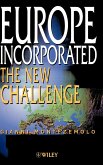Julian Birkinshaw / Sumantra Ghoshal / Constantinos Markides / John Stopford / George Yip (Hgg.)
The Future of the Multinational Company
Ed. by Julian Birkinshaw, Sumantra Ghoshal, Constantinos Markides et al.
Julian Birkinshaw / Sumantra Ghoshal / Constantinos Markides / John Stopford / George Yip (Hgg.)
The Future of the Multinational Company
Ed. by Julian Birkinshaw, Sumantra Ghoshal, Constantinos Markides et al.
- Gebundenes Buch
- Merkliste
- Auf die Merkliste
- Bewerten Bewerten
- Teilen
- Produkt teilen
- Produkterinnerung
- Produkterinnerung
Recent Events -from September 11, to the anti-globalization protests to the collapse of the high-tech boom have accentuated the sense that the global economy is moving into uncharted waters Bringing together the leading authorities on globalization and international business The Future of the Multinational Company looks ahead to the new challenges facing multinational firms and predicts what the multinational company will look like in ten years time. _ Brings together the leading authorities in the field of global / international busi-ness. _ Accademically rigourous but accessible · _ Addresses a topic of concern to practitioners and academics alike…mehr
Andere Kunden interessierten sich auch für
![Multinational Strategic Alliances Multinational Strategic Alliances]() Robert J. MocklerMultinational Strategic Alliances96,99 €
Robert J. MocklerMultinational Strategic Alliances96,99 €![Managing Change Across Corporate Cultures Managing Change Across Corporate Cultures]() Fons TrompenaarsManaging Change Across Corporate Cultures26,99 €
Fons TrompenaarsManaging Change Across Corporate Cultures26,99 €![Global Smarts Global Smarts]() Sheida HodgeGlobal Smarts45,99 €
Sheida HodgeGlobal Smarts45,99 €![Business Across Cultures Business Across Cultures]() Fons TrompenaarsBusiness Across Cultures26,99 €
Fons TrompenaarsBusiness Across Cultures26,99 €![Managing People Across Cultures Managing People Across Cultures]() Fons TrompenaarsManaging People Across Cultures28,99 €
Fons TrompenaarsManaging People Across Cultures28,99 €![The Last Days of the Giants The Last Days of the Giants]() Robert BaldockThe Last Days of the Giants82,99 €
Robert BaldockThe Last Days of the Giants82,99 €![Europe Incorporated Europe Incorporated]() Gianni MontezemoloEurope Incorporated129,99 €
Gianni MontezemoloEurope Incorporated129,99 €-
-
-
Recent Events -from September 11, to the anti-globalization protests to the collapse of the high-tech boom have accentuated the sense that the global economy is moving into uncharted waters Bringing together the leading authorities on globalization and international business The Future of the Multinational Company looks ahead to the new challenges facing multinational firms and predicts what the multinational company will look like in ten years time.
_ Brings together the leading authorities in the field of global / international busi-ness.
_ Accademically rigourous but accessible ·
_ Addresses a topic of concern to practitioners and academics alike
_ Brings together the leading authorities in the field of global / international busi-ness.
_ Accademically rigourous but accessible ·
_ Addresses a topic of concern to practitioners and academics alike
Produktdetails
- Produktdetails
- Verlag: Wiley & Sons
- 1. Auflage
- Seitenzahl: 256
- Erscheinungstermin: 1. August 2003
- Englisch
- Abmessung: 250mm x 175mm x 20mm
- Gewicht: 650g
- ISBN-13: 9780470850657
- ISBN-10: 0470850655
- Artikelnr.: 11407067
- Herstellerkennzeichnung
- Libri GmbH
- Europaallee 1
- 36244 Bad Hersfeld
- gpsr@libri.de
- Verlag: Wiley & Sons
- 1. Auflage
- Seitenzahl: 256
- Erscheinungstermin: 1. August 2003
- Englisch
- Abmessung: 250mm x 175mm x 20mm
- Gewicht: 650g
- ISBN-13: 9780470850657
- ISBN-10: 0470850655
- Artikelnr.: 11407067
- Herstellerkennzeichnung
- Libri GmbH
- Europaallee 1
- 36244 Bad Hersfeld
- gpsr@libri.de
The Editors of this book are recognised as key thinkers in the area of strategy and international business. The book itself is based on a conference held at the London Business School in honour of John Stopford, one of the most influential thinkers in the field of international business. The contributors to this book are leading authorities in the field. This formidable combination of people responsible for this book speaks for itself.
Introduction (Julian Birkinshaw, Sumantra Ghoshal, Costas Markides, John Stopford, George Yip).SECTION 1: RIVAL STATES, RIVAL FIRMS.Chapter 1: The (A)Political Multinational: State-Firm Rivalry Revisited (Louis Turner).Chapter 2: The moral response to capitalism: Can we learn from the Victorians?(John Dunning).Chapter 3: The multi-home based multinational: combining global competitiveness and local innovativeness (Örjan Sölvell).Chapter 4: Regional multinationals: The location-bound drivers of global strategy (Alan Rugman and Alain Verbeke).SECTION 2: MANAGING THE MULTINATIONAL ENTERPRISE.Chapter 5: The evolving multinational: Strategy and structure in Latin American operations, 1990-2000 (Jose de la Torre, Jose Paulo Esperanca and Jon Martinez).Chapter 6: Risk and the dynamics of globalisation (Don Lessard).Chapter 7: The global OEM: The transformation of Asian sup plier companies )(Anthony Leung and George Yip) .Chapter 8: Designing Multinationals: Is it all over now? (Lawrence
Introduction (Julian Birkinshaw, Sumantra Ghoshal, Costas Markides, John
Stopford, George Yip).
SECTION 1: RIVAL STATES, RIVAL FIRMS.
Chapter 1: The (A)Political Multinational: State-Firm Rivalry Revisited (
Louis Turner).
Chapter 2: The moral response to capitalism: Can we learn from the
Victorians?(John Dunning).
Chapter 3: The multi-home based multinational: combining global
competitiveness and local innovativeness (Örjan Sölvell).
Chapter 4: Regional multinationals: The location-bound drivers of global
strategy (Alan Rugman and Alain Verbeke).
SECTION 2: MANAGING THE MULTINATIONAL ENTERPRISE.
Chapter 5: The evolving multinational: Strategy and structure in Latin
American operations, 1990-2000 (Jose de la Torre, Jose Paulo Esperanca and
Jon Martinez).
Chapter 6: Risk and the dynamics of globalisation (Don Lessard).
Chapter 7: The global OEM: The transformation of Asian sup plier companies
)(Anthony Leung and George Yip) .
Chapter 8: Designing Multinationals: Is it all over now? (Lawrence Franko
).
Chapter 9: The customer-focused multinational: revisiting the Stopford and
Wells model in an era of global customers (Julian Birkinshaw and Siri
Terjesen).
Chapter 10: Geography as a design variable (Eleanor Westney).
Chapter 11: Regional Organisations: Beware of the pitfalls (Paul Verdin,
Venkat Subramanian, Alice de Koning and Eline Van Poeck).
Chapter 12: The Metanational: The next step in the evolution of the
Multinational Enterprise (Yves Doz, Jose Santos and Peter Williamson).
SECTION 3: REJUVENATING THE MATURE BUSINESS.
Chapter 13: The critical role of sense-making in Rejuvenating the Mature
Business (John Stopford and Charles Baden-Fuller).
Chapter 14: The invisible underpinnings of corporate rejuvenation:
purposeful action taking by individuals (Sumantra Ghoshal and Heike Bruch
).
Chapter 15: Rejuvenation revisited: Identifying and managing strategy decay
and innovation (Peter Williamson).
Chapter 16: Racing to be second: Innovation through imitation (Costas
Markides).
Chapter 17: Who needs multinationals? Lessons from open-source software
(Rob Grant, Andrea Lipparini, Gianni Lorenzoni, and Elaine Romanelli).
SECTION: 4.
Chapter 18: Management Research: Reprise and Prologue (John Stopford).
Bibliography.
List of Contributors.
Index.
Stopford, George Yip).
SECTION 1: RIVAL STATES, RIVAL FIRMS.
Chapter 1: The (A)Political Multinational: State-Firm Rivalry Revisited (
Louis Turner).
Chapter 2: The moral response to capitalism: Can we learn from the
Victorians?(John Dunning).
Chapter 3: The multi-home based multinational: combining global
competitiveness and local innovativeness (Örjan Sölvell).
Chapter 4: Regional multinationals: The location-bound drivers of global
strategy (Alan Rugman and Alain Verbeke).
SECTION 2: MANAGING THE MULTINATIONAL ENTERPRISE.
Chapter 5: The evolving multinational: Strategy and structure in Latin
American operations, 1990-2000 (Jose de la Torre, Jose Paulo Esperanca and
Jon Martinez).
Chapter 6: Risk and the dynamics of globalisation (Don Lessard).
Chapter 7: The global OEM: The transformation of Asian sup plier companies
)(Anthony Leung and George Yip) .
Chapter 8: Designing Multinationals: Is it all over now? (Lawrence Franko
).
Chapter 9: The customer-focused multinational: revisiting the Stopford and
Wells model in an era of global customers (Julian Birkinshaw and Siri
Terjesen).
Chapter 10: Geography as a design variable (Eleanor Westney).
Chapter 11: Regional Organisations: Beware of the pitfalls (Paul Verdin,
Venkat Subramanian, Alice de Koning and Eline Van Poeck).
Chapter 12: The Metanational: The next step in the evolution of the
Multinational Enterprise (Yves Doz, Jose Santos and Peter Williamson).
SECTION 3: REJUVENATING THE MATURE BUSINESS.
Chapter 13: The critical role of sense-making in Rejuvenating the Mature
Business (John Stopford and Charles Baden-Fuller).
Chapter 14: The invisible underpinnings of corporate rejuvenation:
purposeful action taking by individuals (Sumantra Ghoshal and Heike Bruch
).
Chapter 15: Rejuvenation revisited: Identifying and managing strategy decay
and innovation (Peter Williamson).
Chapter 16: Racing to be second: Innovation through imitation (Costas
Markides).
Chapter 17: Who needs multinationals? Lessons from open-source software
(Rob Grant, Andrea Lipparini, Gianni Lorenzoni, and Elaine Romanelli).
SECTION: 4.
Chapter 18: Management Research: Reprise and Prologue (John Stopford).
Bibliography.
List of Contributors.
Index.
Introduction (Julian Birkinshaw, Sumantra Ghoshal, Costas Markides, John Stopford, George Yip).SECTION 1: RIVAL STATES, RIVAL FIRMS.Chapter 1: The (A)Political Multinational: State-Firm Rivalry Revisited (Louis Turner).Chapter 2: The moral response to capitalism: Can we learn from the Victorians?(John Dunning).Chapter 3: The multi-home based multinational: combining global competitiveness and local innovativeness (Örjan Sölvell).Chapter 4: Regional multinationals: The location-bound drivers of global strategy (Alan Rugman and Alain Verbeke).SECTION 2: MANAGING THE MULTINATIONAL ENTERPRISE.Chapter 5: The evolving multinational: Strategy and structure in Latin American operations, 1990-2000 (Jose de la Torre, Jose Paulo Esperanca and Jon Martinez).Chapter 6: Risk and the dynamics of globalisation (Don Lessard).Chapter 7: The global OEM: The transformation of Asian sup plier companies )(Anthony Leung and George Yip) .Chapter 8: Designing Multinationals: Is it all over now? (Lawrence
Introduction (Julian Birkinshaw, Sumantra Ghoshal, Costas Markides, John
Stopford, George Yip).
SECTION 1: RIVAL STATES, RIVAL FIRMS.
Chapter 1: The (A)Political Multinational: State-Firm Rivalry Revisited (
Louis Turner).
Chapter 2: The moral response to capitalism: Can we learn from the
Victorians?(John Dunning).
Chapter 3: The multi-home based multinational: combining global
competitiveness and local innovativeness (Örjan Sölvell).
Chapter 4: Regional multinationals: The location-bound drivers of global
strategy (Alan Rugman and Alain Verbeke).
SECTION 2: MANAGING THE MULTINATIONAL ENTERPRISE.
Chapter 5: The evolving multinational: Strategy and structure in Latin
American operations, 1990-2000 (Jose de la Torre, Jose Paulo Esperanca and
Jon Martinez).
Chapter 6: Risk and the dynamics of globalisation (Don Lessard).
Chapter 7: The global OEM: The transformation of Asian sup plier companies
)(Anthony Leung and George Yip) .
Chapter 8: Designing Multinationals: Is it all over now? (Lawrence Franko
).
Chapter 9: The customer-focused multinational: revisiting the Stopford and
Wells model in an era of global customers (Julian Birkinshaw and Siri
Terjesen).
Chapter 10: Geography as a design variable (Eleanor Westney).
Chapter 11: Regional Organisations: Beware of the pitfalls (Paul Verdin,
Venkat Subramanian, Alice de Koning and Eline Van Poeck).
Chapter 12: The Metanational: The next step in the evolution of the
Multinational Enterprise (Yves Doz, Jose Santos and Peter Williamson).
SECTION 3: REJUVENATING THE MATURE BUSINESS.
Chapter 13: The critical role of sense-making in Rejuvenating the Mature
Business (John Stopford and Charles Baden-Fuller).
Chapter 14: The invisible underpinnings of corporate rejuvenation:
purposeful action taking by individuals (Sumantra Ghoshal and Heike Bruch
).
Chapter 15: Rejuvenation revisited: Identifying and managing strategy decay
and innovation (Peter Williamson).
Chapter 16: Racing to be second: Innovation through imitation (Costas
Markides).
Chapter 17: Who needs multinationals? Lessons from open-source software
(Rob Grant, Andrea Lipparini, Gianni Lorenzoni, and Elaine Romanelli).
SECTION: 4.
Chapter 18: Management Research: Reprise and Prologue (John Stopford).
Bibliography.
List of Contributors.
Index.
Stopford, George Yip).
SECTION 1: RIVAL STATES, RIVAL FIRMS.
Chapter 1: The (A)Political Multinational: State-Firm Rivalry Revisited (
Louis Turner).
Chapter 2: The moral response to capitalism: Can we learn from the
Victorians?(John Dunning).
Chapter 3: The multi-home based multinational: combining global
competitiveness and local innovativeness (Örjan Sölvell).
Chapter 4: Regional multinationals: The location-bound drivers of global
strategy (Alan Rugman and Alain Verbeke).
SECTION 2: MANAGING THE MULTINATIONAL ENTERPRISE.
Chapter 5: The evolving multinational: Strategy and structure in Latin
American operations, 1990-2000 (Jose de la Torre, Jose Paulo Esperanca and
Jon Martinez).
Chapter 6: Risk and the dynamics of globalisation (Don Lessard).
Chapter 7: The global OEM: The transformation of Asian sup plier companies
)(Anthony Leung and George Yip) .
Chapter 8: Designing Multinationals: Is it all over now? (Lawrence Franko
).
Chapter 9: The customer-focused multinational: revisiting the Stopford and
Wells model in an era of global customers (Julian Birkinshaw and Siri
Terjesen).
Chapter 10: Geography as a design variable (Eleanor Westney).
Chapter 11: Regional Organisations: Beware of the pitfalls (Paul Verdin,
Venkat Subramanian, Alice de Koning and Eline Van Poeck).
Chapter 12: The Metanational: The next step in the evolution of the
Multinational Enterprise (Yves Doz, Jose Santos and Peter Williamson).
SECTION 3: REJUVENATING THE MATURE BUSINESS.
Chapter 13: The critical role of sense-making in Rejuvenating the Mature
Business (John Stopford and Charles Baden-Fuller).
Chapter 14: The invisible underpinnings of corporate rejuvenation:
purposeful action taking by individuals (Sumantra Ghoshal and Heike Bruch
).
Chapter 15: Rejuvenation revisited: Identifying and managing strategy decay
and innovation (Peter Williamson).
Chapter 16: Racing to be second: Innovation through imitation (Costas
Markides).
Chapter 17: Who needs multinationals? Lessons from open-source software
(Rob Grant, Andrea Lipparini, Gianni Lorenzoni, and Elaine Romanelli).
SECTION: 4.
Chapter 18: Management Research: Reprise and Prologue (John Stopford).
Bibliography.
List of Contributors.
Index.









